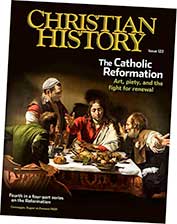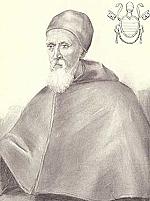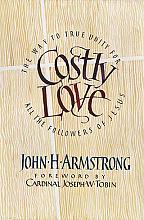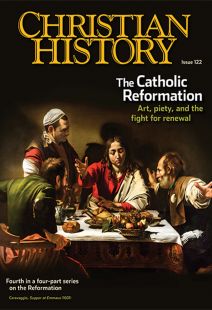Coming to America
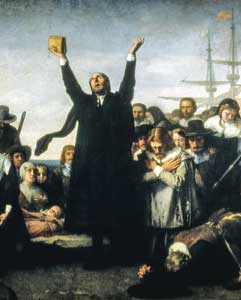
THE WORD “PURITAN” invokes many reactions, not all of them pleasant—as seen in H. L. Mencken’s famous quip that Puritanism is “a haunting fear that someone, somewhere, may be happy.” But such simplification does not do justice to the complicated story, both beautiful and ugly, of these English Dissenters. When their situation in England got too intense, the Puritans took their religious ambitions, ideas, and practices to America. The effects on American culture were profound.
A thoroughly Protestant city
Their story begins in the reign of Queen Mary I of England (1516–1558). Mary, later referred to by Protestants as “Bloody Mary,” sought to take England back for Catholicism—executing almost 300 Protestants along the way, including Thomas Cranmer, the archbishop of Canterbury. While her reign only lasted five years (1553–1558), the ferocity of her persecution had unforeseen effects. Hundreds escaped her grasp and ran to the Continent: to the Netherlands, to Germany, and to Switzerland, especially the city of Geneva. So many ran in fact that they became known as the “Marian exiles.”
Studying under continental Reformed theologians like John Calvin (1509–1564) and Theodore Beza (1519–1605), these exiles adopted certain understandings of Protestantism and its role in the world. In Calvin and his “perfecte schoole of Christe” (as the Scottish reformer John Knox called the city of Geneva), Englishmen and women saw an example of a more thoroughly Protestant city than any that had previously existed.
State and church intertwined everywhere in the sixteenth century, but in Geneva a Protestant church was in the driver’s seat. Church discipline snuffed out even hints of “papist superstition” (like naming your child after a non-Biblical saint). When the exiles returned to England after Mary’s death, they came back with a mission: to make England a thoroughly Protestant nation.
Upon Mary’s death her Protestant sister, Elizabeth (1533–1603), took the throne. Elizabeth did not want to alienate either her Catholic or her Protestant subjects, so she attempted to please the latter without expelling the former—supporting Protestantism theologically but allowing many Catholic practices to continue.
To the newly returned exiles, allowing “popery” a foothold was almost as bad as affirming it outright. There were still bishops. Clergy still wore Catholic vestments. Cathedrals still stood, monuments to late medieval Catholicism. A group of English Protestants influenced by the exiles refused to accept this. They called themselves “the godly.” Others sneered at them, giving them an epithet that would become the name by which we know them: “Puritans.”
By the mid-seventeenth century, tensions over church organization and polity, vestments, and the prayer book reached full boil, as James I of KJV fame (1566–1625) and Charles I (1600–1649) followed Elizabeth and maintained her middle-of-the-road policies.
Many Puritans thought polity ought to be Presbyterian—using Calvin’s fourfold offices of doctors, preachers, elders, and deacons. They denounced the Anglican hierarchy of bishops and archbishops as oppressive and unbiblical, and they argued that vestments suggested visibly that clergy and laity were two separate spiritual categories. They thought of the Book of Common Prayer as, in the famous words of one critic, “an unperfect book, culled and picked out of that popish dunghill the Mass book, full of all abominations.” Its prescription of a closely ordered service was needlessly restrictive and, to some, Holy-Spirit-quenching.
Fight, flee, or conform
As resistance from the king and the archbishops of Canterbury, especially William Laud, ramped up, nonconformists had the option of conforming, fighting, or fleeing to build their homes elsewhere. Some attempted to conform and maintain their distinctive piety underground. The English Civil War between 1642 and 1651 was the triumph of the fighters, who saw the marriage of church and state as the proper way to establish a thoroughly Protestant nation. For those who chose to flee, North America was an enticing option.
When they went to America, the Puritans bore their distinctive piety with them in a body of literature that painstakingly treats spiritual malaise, stagnation, and conflict. Is there a sin that continues to loom over your head, day after day, week after week? See John Owen’s Of the Mortification of Sin in Believers; the Necessity, Nature, and Means of It (1656). Are envy and restlessness your problems? Read Jeremiah Burroughs’s The Rare Jewel of Christian Contentment (1648). Are you suffering and struggling to understand what Romans 8:28 means? See Thomas Watson’s All Things for Good (1663).
Order Christian History #122: The Catholic Reformation in print.
Subscribe now to get future print issues in your mailbox (donation requested but not required).
The piety of these pages illustrates the Puritans’ continual discernment of sin and unrelenting personal struggles against it. For “godly” men and women, holiness was not an option, but a requirement, an act of gratitude for the salvation that they enjoyed in Jesus Christ. Their Calvinism was lively, penetrating their minds, emotions, and souls.
The Puritan embrace of Reformed orthodoxy manifested itself in a relentless drive for consistent scriptural application. Spiritual renewal was not merely an individual project, but a communal one rooted in the covenants that God made with his people.
One of the most concrete examples of this commitment was advocacy for the Christian Sabbath. In England this was one desired Puritan reform that lasted beyond the restoration of the English monarchy in 1660 following the Civil War and the Protectorate of Oliver Cromwell (1599–1658). The Puritans took the Sabbath wholesale to the American colonies.
Theologically this was rooted in obedience to the Fourth Commandment, linking Sabbath rest to God’s rest on the seventh day of creation. Puritans, as many Christians before and after, celebrated their Sabbath on Sunday, viewing God’s initial creation in Genesis as parallel to the new creation inaugurated by Christ upon his Resurrection. That Resurrection put Christians under a light yoke, Puritans thought: to observe the Christian Sabbath by sanctifying it entirely to God, resting from work, and devoting it to worship, fellowship, and gratitude.
For the Puritans communal spiritual renewal did not stop with the community of faith. They ultimately failed to gather the power to consistently apply many of their principles to the government of England, even when they controlled Parliament (1649–1660). But even as they were failing in “Old England,” in New England they had a new opportunity to test the marriage of church and state.
“Hail, holy land”
John Winthrop (1587–1649), lawyer and first governor of the Massachusetts Bay Colony, preached about New England as “a city upon a hill”—hoping it would be a Christian society, inhabited and led by godly Christians committed to applying God’s word to the structures of society. John Cotton (1585–1652), another famous New England preacher, linked the settling community in New England to Israel explicitly. Just as Israel was God’s chosen people, run as a theocracy—a form of government where all authority derives from God—so the Puritans thought they were God’s chosen people and should govern themselves in the same way. Poet Thomas Tillam wrote in “Upon the First Sight of New England” (1638):
Hail, holy land, wherein our holy Lord
hath planted his most true and holy Word.
Hail, happy people, who have dispossessed
yourselves of friends, and means, to find some rest
for your poor wearied souls, oppressed of late
for Jesus’ sake, with envy, spite, and hate. …
Possess this Country; free from all annoy,
Here I’ll be with you, here you shall enjoy
my Sabbaths, sacraments, my ministry
and ordinances in their purity.
This Puritan vision inspired later ideas of America as a “Christian nation.” But though many original immigrants were faithful Christians, settlement required childbearing and new generations. Unfortunately nothing guaranteed these new generations would be as faithful as the first. The Puritans vigorously attempted to guard against this, writing catechisms like John Cotton’s Milk for Babes, Drawn Out of the Breasts of Both Testaments (1646) and books on family worship. But as children were born into covenant communities, they had to negotiate their own faith. It did not always turn out the way that their parents wanted.
Danger in the promised land
This was not the only danger. Those who did not conform to the Puritan religious establishment suffered persecution at the hands of the very people who had faced such persecution in England. Some fled the Massachusetts Bay Colony to places like Rhode Island and Pennsylvania.
And of course the “New World” was not really new. The Puritans constantly preached about the humanity of Native Americans and the need to evangelize and Christianize them, while they also slaughtered them and took their lands. Here their self-understanding as Israel led them to identify the Native Americans as Canaanites, obstacles to the Promised Land. After all if God had given them this land, who would dare stand in their way?
Interaction with Africans became an even deeper tragedy. Many of the early Puritan settlers had slaves and argued that the practice was justified. Darker African skin took on a meaning of impurity, amplified by Puritan readings of Aristotle and of contemporary English chroniclers of African life. Even while Puritans consistently preached the democratizing nature of sin and the universal invitation of the Gospel, the bodies of their neighbors were still treated as inferior under the biblical injunctions affirming slavery.
Stories range from Jonathan Edwards’s cousin Stephen Williams who beat two slaves so severely they took their own lives, to William Billing’s slave Caesar, publicly whipped and then sold after Caesar and Billing’s daughter Lucy had a little girl together whom they named Patience. (Or as it was entered in the legal records, Caesar “wickedly and willingly had carnal knowledge of the body of Lucy Billing an English woman an infant and Daughter of William Billing.”) Lucy too was whipped. Two years later Patience died.
A few Puritans, like Judge Samuel Sewall in The Selling of Joseph (1700), spoke out against slavery:
All Men, as they are the Sons of Adam, are Coheirs; and have equal Right unto Liberty, and all other outward Comforts of Life. … Originally, and Naturally, there is no such thing as Slavery. Joseph was rightfully no more a Slave to his Brethren, than they were to him: and they had no more Authority to Sell him, than they had to Slay him.
But they were few and far between. Africans and Native Americans, perhaps more than any, knew whether the Puritans truly, holistically practiced what they preached. On one hand Puritan piety was impressive, and their zeal for Christ and steadfastness in the midst of persecution were admirable. On the other hand, they left a legacy of relationship with other races and faiths that never fully lived out the promise with which Tillam’s poem continues:
But yet beware of Satan’s wily baits.
He lurks among you. Cunningly he waits
to catch you from me. Live not, then, secure
but fight ’gainst sin, and let your lives be pure. CH
This article is from Christian History magazine #122 The Catholic Reformation. Read it in context here!
Christian History’s 2015–2017 four-part Reformation series is available as a four-pack. This set includes issue #115 Luther Leads the Way; issue #118 The People’s Reformation; issue #120 Calvin, Councils, and Confessions; and issue#122 The Catholic Reformation. Get your set today. These also make good gifts.
By Malcolm Foley
[Christian History originally published this article in Christian History Issue #122 in 2017]
Malcolm Foley is a Ph.D. student in the history of Christianity at Baylor University.Next articles
Remaking the world
Five men with very different ideas on the reform of Sixteenth-century Catholicism
Edwin and Jennifer Woodruff TaitThe Catholic Reformation: Recommended Resources
Here are some recommendations from CH editorial staff and this issue’s authors to help you navigate the landscape of the Catholic Reformation and the effects of reform on into the seventeenth century.
the editorsThree featured paintings
Three paintings that put Comenius’s life and times in perspective.
the editorsSupport us
Christian History Institute (CHI) is a non-profit Pennsylvania corporation founded in 1982. Your donations support the continuation of this ministry
Donate



